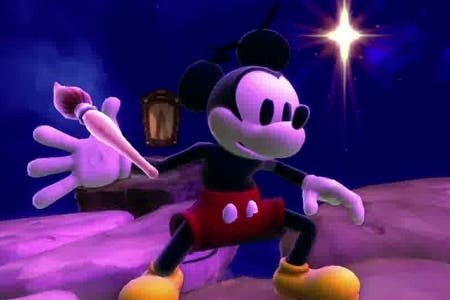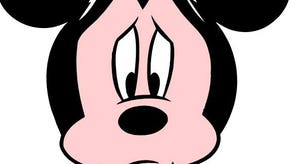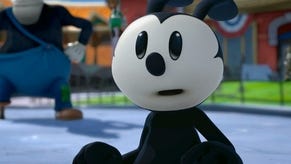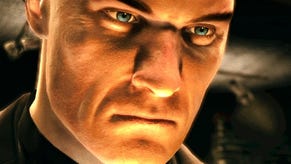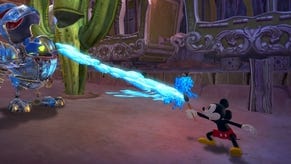Disney's Epic Mickey 2: The Power of Two review
The tragic kingdom.
For a period in the 1940s, Mickey Mouse was given ears that worked properly in perspective. It was a concession to shifts in animation styles and the increased fidelity that could be brought to contemporary cartoons, most probably, but it looked weird. It looked awkward, in fact, and it made Mickey look awkward, too. Barely a mouse in any meaningful sense by this stage, the studio's star was having trouble transitioning from the primitive, scribbled energy of the early short films into something a little more elaborate. He was a 2D doodle struggling to cope in an increasingly complex world.
Plenty of those sorts of growing pains were apparent in 2010's Epic Mickey. Comfortable in the lavish, pleasantly straightforward 16-bit classics from the 1990s, Disney's mascot was suddenly thrust into an intricate 3D landscape, and delivered into the hands of a design team who were encouraged to think big. He'd deal with morality, with all its choices and consequences! He'd wield a magical paintbrush that would allow him to create or destroy huge chunks of the environment using blasts of paint and thinner! He'd battle an enemy, in the shape of Oswald the Lucky Rabbit, who was a spurned Disney headline act yanked from the archives! He'd navigate an adventure that was as much about an unusually clear-eyed deconstruction of a historical license and an examination of the tattered human craft that goes into creating fantastical confections - and of the casualties that litter the path to success - as it was jumping, fighting, and collecting things!
It was a game with plenty of problems, but from the vantage point of Epic Mickey 2, it's hard to look back on with anything but wistful nostalgia. During previews, Junction Point's sequel often sold itself as a musical. Ultimately, however, the finished product's more of a tragedy. That's not to say it's a buggy wall-to-wall botch: it's certainly wonky and annoying to play at times, but its worst flaws are textural. Mickey's second Wasteland adventure is a tragedy because it's a missed opportunity. Two games in, and there's a great experience hidden somewhere inside Disney's jumbled series, but it refuses to emerge in full. Worse yet, this sequel sees Epic Mickey's strange promise slipping further away. The echoes of clever, imaginative fun grow distant, while the compromises - and the odd failure of design nerve - begin to really pile up.

The original Epic Mickey was a bold game hampered by awkward implementation. It was ambitious in tone, and let down by its mechanics. Those mechanics have changed a bit for the sequel, but they haven't really become that much more satisfying. The ambition, meanwhile. has drained away a little, leaving behind the shell of a rather pretty children's game (albeit one that will seriously annoy most children over the long run) without much to sustain it.
And so Epic Mickey 2 is a far simpler adventure, leaning less on Disney's mysterious, richly fascinating history and more on basic 3D platforming dressed up with the odd puzzle and the occasional famous cameo. Oswald's a cheerful goody from the off and the Wasteland, while suffering from a series of mysterious earthquakes, is a far brighter, less claustrophobic, less interesting world to explore. Nobody's bitter about being forgotten, and nobody's about to undergo a premature autopsy, as Mickey almost did at the start of the first adventure. Even the villainous mad doctor's turned angelic (or has he?) with a nutty plan to save the Wasteland, and a new habit of speaking in song.
Those songs are the first signs of a creeping timidity. For all the marketing blather, Epic Mickey 2 isn't a musical game in any meaningful sense. While Warren Spector has said during previews that he has ideas for working music properly into the design, this outing's testing the waters, and the tunes aren't allowed any purchase in the sphere of mechanics, where they would actually make some kind of impact. Instead, this is a non-musical adventure with a couple of songs stuck in the cut-scenes and mid-action voiceovers - and the songs themselves aren't classics. A lot of the time, they aren't even really songs, to be honest: they're just elbowy lumps of bare-bones exposition set to a lacklustre orchestral muddle.
The game that takes place beneath all this warbling, meanwhile, fails to improve on the original. Playing as Mickey, the focus is back on meddling with the world via paint and thinner, which allows you to rub out certain pieces of geometry to reveal secrets lurking inside, or fill them back in again and restore the embattled landscape to its former glory. Once again, it's a lovely visual trick the first few times you do it, as fresh terrain slurps its way across the environment, nestling into ghostly outlines, or retreating from little knotholes. It still isn't an inherently entertaining interaction, however, and it's rarely used in ways that are more imaginative than peeling away a boss's armour, or piecing a broken pathway together so you can reach the next location.
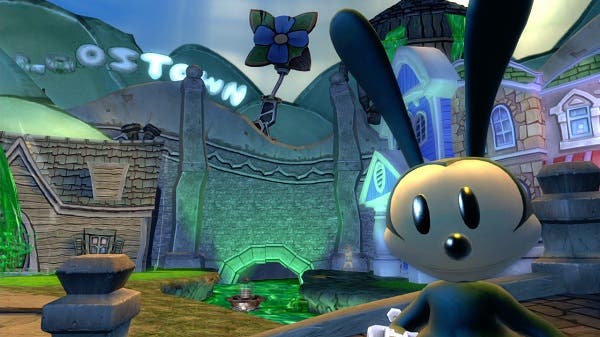
Paint and thinner, with the system's roving reticule, were presumably one of the reasons the first game's camera was so infuriating, even by the standards of third-party Wii fare. Now the series has gone multi-platform, and although we haven't been able to test the Wii version this time around, the PlayStation Move controls certainly suggest a degree of refinement as far as motion-sensor peripherals are concerned, with your paint-spraying ambitions battling the whims of the automatic camera far less regularly. The best way to play the game, however, is probably with a standard 360 or PS3 controller, where paint and thinner are mapped to triggers, and the camera and paintbrush combo lurks down on the right thumbstick.
It's still a little slow to react at times, since you're moving the aiming reticule around for a bit before the viewpoint starts to actually shift, but it offers a lot more precision overall. Personally, I can't shake the feeling that the whole paint and thinner business is still not quite a good enough idea by itself to justify busting your camera system over, however. I'm not sure it's earning its place in the game given all the trouble it causes - not even when it's linked to rudimentary moral choices as you decide whether to thin enemies to destroy them or paint them to render them friendly, or pick between solving puzzles using quick strokes of destructive thinking or employing more elaborate and creative solutions.
Even with a better camera, the platforming is still a little unwieldy, mind. Mickey continues to struggle with slippy, slidy ledges, he jogs rather arthritically, and he simply isn't as much fun to throw around as most other gaming heroes. Chuck in extremely iffy contextual button interactions and it can grow quietly wearying. Throw a problematic AI companion on top and it really starts to grate.
Ah, Oswald. He's only an AI companion if you're playing solo, of course. Put a player in there and he's much less likely to cause annoyances. Drop-in, drop-out action is nice and simple, and although you can't select Oswald as your main man if you're playing the game by yourself, a few minutes of local-only co-op will reveal that you wouldn't really want to anyway.
Oswald's skills are not even as much fun as Mickey's, frankly, and human sidekicks are going to feel a little cheated. He's got a boomerang limb for ranged combat and a remote control for zapping enemies or charging gadgets in the environment. He can hover in the air after a jump by spinning his ears, too, which is nice, given the slightly woolly platforming. He can also give Mickey airlifts over long gaps, and this is nice in theory but extremely annoying in practice if you're working through single-player.

This is because Oswald's AI is unreliable, and unreliable is almost worse than outright bad in some respects, because you can harbour noble hopes that things will get better, and because you will live in fear of sequences where everything falls apart at the worst possible instant.
Don't get me wrong: for decent stretches of the game, Oswald presents few problems, navigating complex terrain - or at least warping to your side when he's struggling - responding to stabs of the summon or the group interact button (both of which could do with a little more feedback to suggest they're actually working), and even reviving you now and then when you're downed by a baddy. Suddenly, he'll refuse to play along, however, ignoring prompts to mess with machinery, preferring to run around wildly instead of air-lift you from the sinking platform you're on, or just merrily suiciding himself on seemingly hazard-free parts of the scenery.
Watch him from the corner of your eye and you'll see what a disaster he can be even when it feels like he's behaving: jogging against walls, plummeting from this or that, and racing in giddy circles. He's a wonderful slapstick presence in this respect - and his animation, with those windmilling legs and vacant lurches, is top-notch to be fair - but it's hard to see any of his comedy as intentional, particularly when, in pressure-sensitive co-op moments, he's failing to be a dependable ally. The worst of it is that the series' rather poor visual sign-posting of its challenges means you sometimes can't tell whether Oswald's breaking a puzzle or if it's simply been presented to you in a way that doesn't make much sense and so you're busy trying the wrong thing. Kids love that, right? You know: tortured puzzle logic that doesn't make clear graphical sense, AI partners that can't be trusted.
No, actually: the worst of it is that, due to Oswald's behavioural problems, it seems the developers have really limited the game design to match his fumbled AI. On balance, this is better than having him struggle to pull off too many key interactions, perhaps, but it means that it's a rare puzzle that goes beyond Mickey pulling or painting something to expose a chunk of electronics for Oswald to zap, or Mickey dragging firework bombs for Oswald to then ignite. Yes, it's a game for kids, but these joyless activities feel placeholder regardless of your age, and co-op ultimately comes across as another sacrifice, another questionable choice of focus in a series whose actual mechanics were already a little feeble.
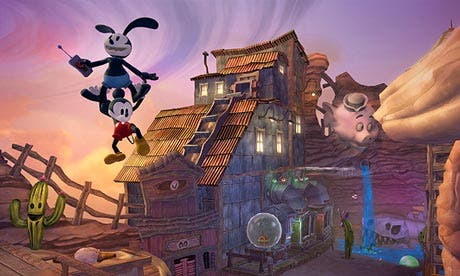
Combat remains weightless and unsatisfying whether you're paintbushing or electrocuting foes before bashing them, and boss fights grind on too long. The visual design for your enemies is great, of course, from clanking, overheating robots to mechanised roadsters hopping around on fat wheels, but you'll still sigh when you see them looming, stylishly, over the next crest.
That's a bit of a theme, really: Epic Mickey continues to be a series for art designers rather than level designers. One by one, tantalising locations race towards you - a tumbledown Western gulch, a spooky Southern bog with dark trees on the horizon and crocodiles lurking in the water, good old Autotopia with its looping highways and pastel-coloured 1950s cheer - and you can't wait to visit them. Drop in, though, and you'll quickly find the same creaking puzzles unenlivened by the fact that many of them can be approached in a handful of different ways, the same lame brawling and fiddly platforming. Everything looks beautiful, but that only makes the game's failings more depressing. The gorgeous chalky cut-scenes once again reveal a project that's in love with concept art, but you're left with that feeling you sometimes get when you check out the extra content on a bad Sci Fi DVD: that sense of glorious creative brainstorming having given way to an underwhelming final product. It's a game of ideas and about ideas: it just never quite reaches the point where its best ideas are implemented in coherent ways.
So while the art design and the sheer Disneyalia remain as appealing as ever, a retreat to a less interesting narrative - and a much safer treatment of the world and cast - show up the game's shortcomings fairly harshly. Play on 360 or PS3 (the Wii version is exactly the same as far as features are concerned, apparently) and the leap to HD consoles has been handled relatively well, with improved assets and the odd decent texture - but without the dark spirit of the original, it becomes a rather empty journey: a tour of a nicely-arranged fairground where none of the rides are actually worth queuing for. Once again the game's systems fail to merge cohesively with the landscape. There's certainly nothing like that fusion of character, skills, and environment that Mario offers to such rhythmic effect.
Throughout the tangled adventure, Junction Point clings to one classic Disneyland idea, of course: the Hidden Mickey - the moment where three circles join to create that iconic silhouette. In truth, Mickey's lost rather than merely hidden here, trapped within a game that won't come into focus. Fascinating and frustrating by turn, there's just enough to make you cling to the hope that one day the development team will actually find him. For now, I'd love the big, glossy, elephant folio art book of the Epic Mickey series, but I can probably do without the games themselves.
